The Night Vision Surveillance Cameras Market is estimated to be valued at USD 199.2 billion in 2025 and is projected to reach USD 1491.3 billion by 2035, registering a compound annual growth rate (CAGR) of 22.3% over the forecast period.
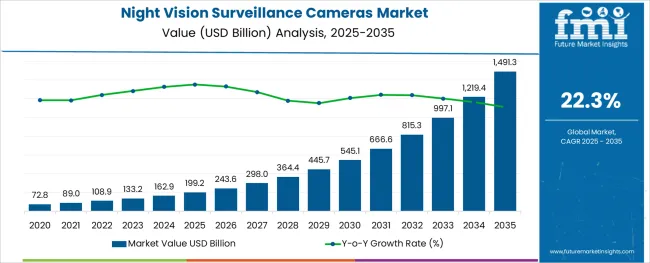
The night vision surveillance cameras market has gained strong traction in recent years, driven by the escalating demand for advanced security solutions capable of operating effectively under low-light and no-light conditions. Increasing concerns over property crime, perimeter security, and urban safety have accelerated the adoption of these systems across both residential and commercial sectors.
Additionally, the proliferation of smart city initiatives and the growing integration of artificial intelligence in surveillance technology have further bolstered market expansion. Continuous improvements in image resolution, infrared technology, and thermal imaging capabilities have enhanced the effectiveness and reliability of night vision cameras, supporting their widespread use in critical infrastructure, transportation, and industrial facilities.
Moving forward, the market is anticipated to witness steady growth as end-users prioritize 24/7 security monitoring and invest in infrastructure upgrades. Heightened awareness regarding workplace safety and regulatory mandates surrounding public surveillance are also expected to sustain demand across multiple regions. The convergence of surveillance systems with IoT platforms and cloud-based video analytics will continue to reshape the competitive landscape, offering new revenue opportunities for manufacturers and service providers.
The market is segmented by Product Type, Type, and End Use Application and region. By Product Type, the market is divided into Dome Camera, Bullet Camera, and Box Camera. In terms of Type, the market is classified into PTZ (Pan, Tilt, and Zoom) and Fixed. Based on End Use Application, the market is segmented into Retail, Business Organization, Transportation, Public Sector and Defense, Industrial, Stadiums, and Others. Regionally, the market is classified into North America, Latin America, Western Europe, Eastern Europe, Balkan & Baltic Countries, Russia & Belarus, Central Asia, East Asia, South Asia & Pacific, and the Middle East & Africa.
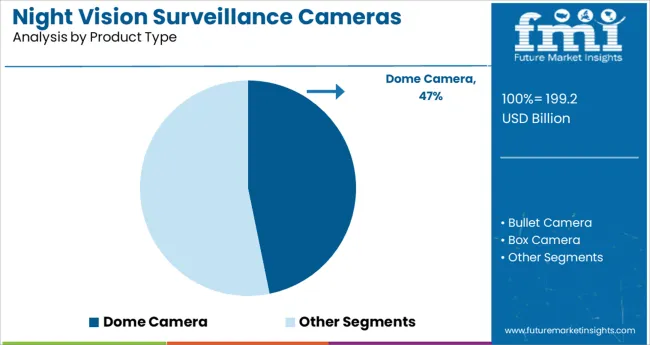
The dome camera segment captured approximately 46.8% of the total night vision surveillance cameras market, establishing itself as the dominant product type category. This leadership position is underpinned by the product’s discreet design, which allows for unobtrusive surveillance in both indoor and outdoor settings, making it particularly suitable for retail, hospitality, and corporate environments.
Dome cameras are frequently favored for their wide-angle coverage, ease of installation, and resistance to tampering or vandalism. The integration of night vision and infrared LED capabilities has expanded their utility in low-light and complete darkness scenarios, driving consistent demand in commercial applications.
The growing need for continuous surveillance and security infrastructure modernization across densely populated urban centers has reinforced the segment’s prominence. Additionally, enhanced product variants offering remote control, motion detection, and compatibility with cloud-based monitoring solutions have improved operational efficiency and reduced response times to security incidents. As manufacturers focus on developing AI-powered dome cameras with advanced video analytics, facial recognition, and automatic alerts, this segment is projected to maintain its leading market share in the years ahead.
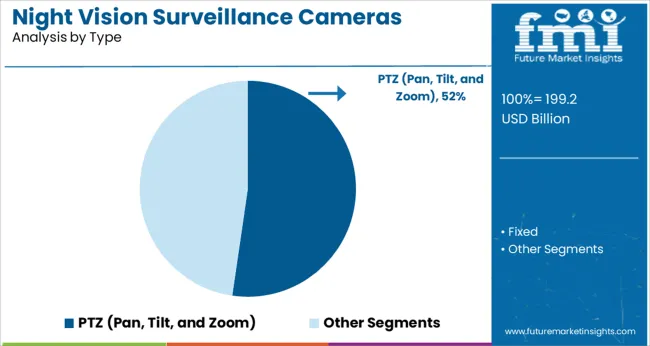
Within the type category, the PTZ (Pan, Tilt, and Zoom) segment secured a substantial 52.3% market share, reflecting its strong position as the preferred camera configuration for dynamic, real-time monitoring applications. The segment’s leadership is attributed to the device’s flexibility, enabling operators to remotely control the camera’s orientation and focal length, which is essential for tracking moving objects and covering large or complex surveillance zones.
PTZ cameras equipped with night vision and high-definition imaging have become indispensable in critical security installations such as transportation hubs, industrial plants, and border control areas. Continuous advancements in PTZ technology, including 360-degree rotation, long-range infrared illumination, and integration with AI-based tracking systems, have enhanced operational effectiveness in challenging lighting conditions.
The increasing prioritization of proactive threat detection and situational awareness has accelerated the deployment of these cameras in public safety and government infrastructure projects. Future market growth for the PTZ segment is expected to be driven by the demand for fully automated surveillance solutions capable of intelligent monitoring, object recognition, and rapid incident response in diverse operational environments.
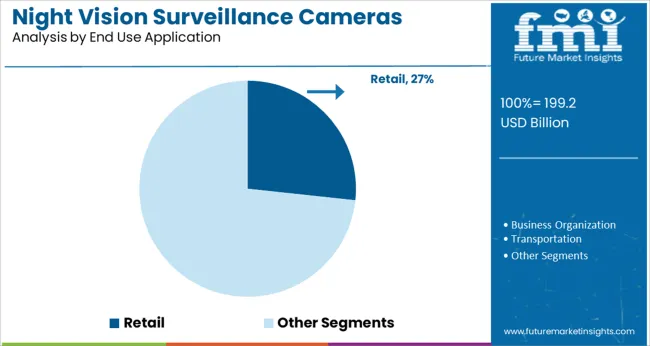
In terms of end use application, the retail segment led the night vision surveillance cameras market with a 26.7% share, supported by rising security concerns within commercial establishments and the growing need to deter theft, vandalism, and inventory shrinkage. Retailers have increasingly recognized the value of comprehensive surveillance systems, particularly those capable of capturing clear footage in low-light conditions, to safeguard merchandise, monitor customer behavior, and enhance overall store security.
Night vision cameras, especially those integrated with motion detection and facial recognition capabilities, have gained traction in shopping malls, supermarkets, and convenience stores. The heightened emphasis on customer safety and regulatory compliance related to workplace security standards has also contributed to the segment’s expansion.
As retailers modernize their infrastructure with cloud-based video management systems and AI-driven analytics for operational optimization, the reliance on advanced night vision surveillance cameras is expected to intensify. The anticipated rollout of 24/7 monitoring frameworks and integrated incident management platforms will further support the sustained growth of this application segment over the forecast period.
The night vision surveillance cameras market study indicates that because they ensure personal safety, night vision security cameras are rapidly being used in homes and offices. Through video analytics, night vision security cameras can now zoom in to disclose someone's identity, which can be valuable to crime prevention when used correctly.
The criminal is easily arrested. As a result, buyers are becoming increasingly interested in night-vision security cameras. One of the primary aspects driving the night vision surveillance cameras market is large investments in safe residential and public infrastructure.
The smart home security camera with night vision can detect, recognize, analyze, and track people, cars, and objects. This is handy when looking for motion in a quiet environment over the course of a long video recording. Object size and sensitivity are two factors that can be tweaked. As a result of these recent developments in the night vision surveillance cameras market, the use of smart night vision security cameras is on the rise these days.
The surge in terrorist activities, political tensions over border issues, and security and safety concerns have resulted in huge demand for NVDs in the military and defense industries. To meet the growing demand for night patrolling and combat operations, the military and defense sectors are embracing NVDs. Government investments in NVDs by nations like China, India, Germany, Russia, the USA, and others are likely to drive night vision surveillance cameras market size throughout the forecast period.
Of its multi-tasking capabilities across many military and defense applications, the night vision surveillance cameras market is rapidly expanding. High manufacturing costs, owing to the usage of unique materials such as night vision optics and the utilization of costly third-generation technologies, are expected to impede the night vision surveillance cameras market growth.
Due to the expensive expense of NVDs, such as night-vision goggles, their adoption is limited, and these devices are mostly employed by the military. Due to political issues, certain manufacturers are forced to maintain high costs. This could hinder the night vision surveillance cameras market adoption of NVDs like goggles and scopes.
One of the key developments is the incorporation of near-infrared (NIR) imaging technology into night vision systems. It enables soldiers to attack and reveal the location of victims in any weather. Because of its capacity to identify and track motions occurring in the dark, improved NIR devices are becoming more popular. To improve the customer experience, key night vision surveillance cameras market players are focusing on launching advanced products.
In one of the recent developments in the night vision surveillance cameras market, OmniVision Technologies, Inc., for example, unveiled its second-generation near-infrared (NIR) technology - Nyxel 2 - for night-vision and machine-vision applications in March 2024. This technology delivers a wider field of vision, superior quality, and the ability to work in low to no ambient light.
The night vision surveillance cameras market is segmented into product type, type, end-use application, and region.
The market for night vision surveillance cameras is divided into fixed and PTZ cameras based on type. During the projection period, PTZ (Pan Tilt and Zoom) is expected to have the highest CAGR of 22%. Infrared or thermal cameras, which produce black and white images, are employed at night and in dimly lit regions.
Since it is remotely directed and capable of zoom control, the PTZ (pan-tilt-zoom) camera is widely employed for security applications. Based on the product type, the market is segmented into box cameras, bullet cameras, and dome cameras.
The defense and public sectors have the biggest demand for night vision surveillance cameras. It is anticipated to have a prodigious CAGR of 21.6% during the projected period. Recent terror assaults on essential infrastructure have brought safety concerns to the forefront.
Banking, health, power, water supply, and communication networks have all been targets of sophisticated terror strikes in recent years. Any attack on essential infrastructure might leave a country's economy extremely exposed to future calamity.
As a result, any government's primary goal should be to ensure their protection. As a result, the adoption of night vision surveillance cameras in the public sector is accelerating. Aside from terror attacks, increased concerns about natural catastrophes, criminal activity, accidents, and accidents have also contributed to this segment's high market share.
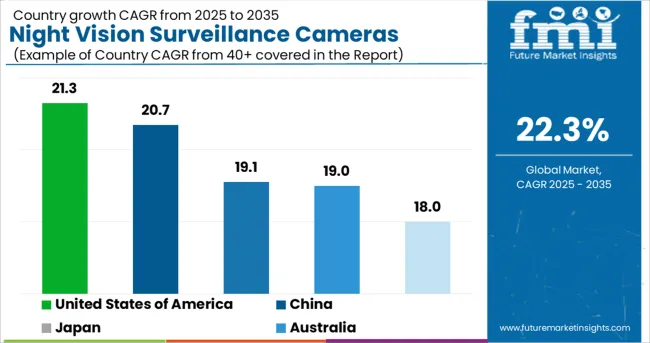
| Regions | CAGR (2025 to 2035) |
|---|---|
| United States of America | 21.3% |
| China | 20.7% |
| Japan | 19.1% |
| Australia | 19% |
| South Africa | 18% |
During the forecast period, North America is expected to dominate the market, with a projected value of USD 195.4 billion. Rising security breaches and increased reliance are driving up demand for night vision systems in countries like the USA and Canada. The federal governments of the USA and Canada have chosen night vision technology to improve security in public applications.
In the coming years, Asia Pacific is predicted to grow at an exponential rate, with an anticipated market size of USD 25.3 billion. The rise in demand for location-based gadgets across government sectors, and public transportation such as airports, train stations, and bus stations, is responsible for the expansion. In addition, growing military spending in the region will boost demand for night vision surveillance cameras in a variety of businesses.
During the projection period, Europe is expected to grow at a significant rate. This expansion is due to the existence of a large number of significant manufacturers. During the forecast period, the Middle East and Africa (MEA) and Latin America regions are predicted to grow at a steady rate. This increase is due to the local government's increased investment in modern night vision surveillance devices, such as cameras, goggles, glasses, and others.
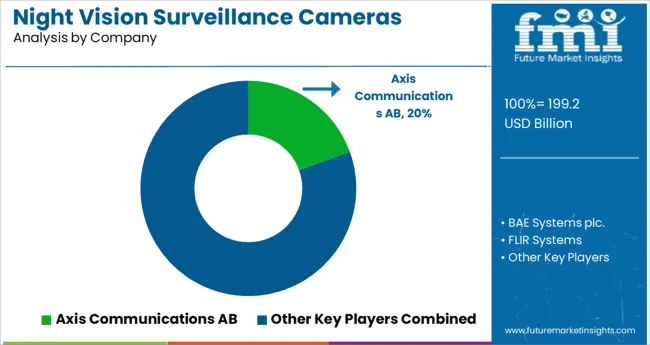
The market for night vision surveillance cameras is fragmented, with a significant number of companies competing. Leading companies are now focusing on providing clients with technologically improved products. Increased demand for night vision surveillance cameras, along with lower long-term costs, is predicted to motivate investors to invest in this technology in the coming years, resulting in increased market rivalry.
Players in the night vision surveillance cameras market are primarily focused on the creation of creative and efficient products. The findings illustrate how rivals are capitalizing on the potential in the night vision surveillance cameras market. The following are some of the most recent advancements in the night vision surveillance cameras market:
The global night vision surveillance cameras market is estimated to be valued at USD 199.2 billion in 2025.
It is projected to reach USD 1,491.3 billion by 2035.
The market is expected to grow at a 22.3% CAGR between 2025 and 2035.
The key product types are dome camera, bullet camera and box camera.
ptz (pan, tilt, and zoom) segment is expected to dominate with a 52.3% industry share in 2025.






Our Research Products

The "Full Research Suite" delivers actionable market intel, deep dives on markets or technologies, so clients act faster, cut risk, and unlock growth.

The Leaderboard benchmarks and ranks top vendors, classifying them as Established Leaders, Leading Challengers, or Disruptors & Challengers.

Locates where complements amplify value and substitutes erode it, forecasting net impact by horizon

We deliver granular, decision-grade intel: market sizing, 5-year forecasts, pricing, adoption, usage, revenue, and operational KPIs—plus competitor tracking, regulation, and value chains—across 60 countries broadly.

Spot the shifts before they hit your P&L. We track inflection points, adoption curves, pricing moves, and ecosystem plays to show where demand is heading, why it is changing, and what to do next across high-growth markets and disruptive tech

Real-time reads of user behavior. We track shifting priorities, perceptions of today’s and next-gen services, and provider experience, then pace how fast tech moves from trial to adoption, blending buyer, consumer, and channel inputs with social signals (#WhySwitch, #UX).

Partner with our analyst team to build a custom report designed around your business priorities. From analysing market trends to assessing competitors or crafting bespoke datasets, we tailor insights to your needs.
Supplier Intelligence
Discovery & Profiling
Capacity & Footprint
Performance & Risk
Compliance & Governance
Commercial Readiness
Who Supplies Whom
Scorecards & Shortlists
Playbooks & Docs
Category Intelligence
Definition & Scope
Demand & Use Cases
Cost Drivers
Market Structure
Supply Chain Map
Trade & Policy
Operating Norms
Deliverables
Buyer Intelligence
Account Basics
Spend & Scope
Procurement Model
Vendor Requirements
Terms & Policies
Entry Strategy
Pain Points & Triggers
Outputs
Pricing Analysis
Benchmarks
Trends
Should-Cost
Indexation
Landed Cost
Commercial Terms
Deliverables
Brand Analysis
Positioning & Value Prop
Share & Presence
Customer Evidence
Go-to-Market
Digital & Reputation
Compliance & Trust
KPIs & Gaps
Outputs
Full Research Suite comprises of:
Market outlook & trends analysis
Interviews & case studies
Strategic recommendations
Vendor profiles & capabilities analysis
5-year forecasts
8 regions and 60+ country-level data splits
Market segment data splits
12 months of continuous data updates
DELIVERED AS:
PDF EXCEL ONLINE
Night Vision System Market Growth - Trends & Forecast 2024 to 2034
Night Vision Device Market
Over-night Hair Treatment Products Market Size and Share Forecast Outlook 2025 to 2035
Quad-tube Night Vision Goggle Market Size and Share Forecast Outlook 2025 to 2035
Automotive Night Vision Sensors Market Size and Share Forecast Outlook 2025 to 2035
Automotive Night Vision System Market Size and Share Forecast Outlook 2025 to 2035
Automotive Night Vision Market
Age-Defying Night Creams Market Analysis - Size and Share Forecast Outlook 2025 to 2035
Retinoid-Infused Night Creams Market Analysis - Size, Share, and Forecast Outlook 2025 to 2035
Europe Automotive Night Vision System Market Size and Share Forecast Outlook 2025 to 2035
Vision Screener Market Size and Share Forecast Outlook 2025 to 2035
Vision Care Market Size and Share Forecast Outlook 2025 to 2035
Vision Guided Robots Market - Trends & Forecast 2025 to 2035
Vision Sensor Market by Type, Application, End user and Region through 2035
Revision Knee Replacement Market Size and Share Forecast Outlook 2025 to 2035
PCB Vision Inspection Equipment for SMT Market Size and Share Forecast Outlook 2025 to 2035
Television Broadcasting Services Market Insights – Growth & Forecast 2023-2033
Television Services Market
Smart Vision Processing Chips Market Size and Share Forecast Outlook 2025 to 2035
Smart Vision Sensors Market Analysis - Size, Share, and Forecast Outlook 2025 to 2035

Thank you!
You will receive an email from our Business Development Manager. Please be sure to check your SPAM/JUNK folder too.
Chat With
MaRIA